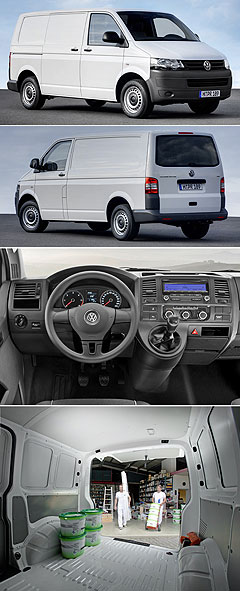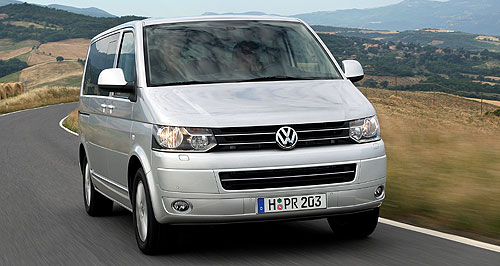Make / Model Search
Future models - Volkswagen - TransporterVW’s hi-tech haulers headed our wayLoaded: The VW Transporter gets upgraded common-rail diesel engines and optional dual-clutch transmission in the revised T5 range. Volkswagen peps up T5 commercials with classy diesels and dual-clutch auto22 Sep 2009 By JAMES STANFORD in ITALY VOLKSWAGEN has applied some of its best technology to the significantly revised T5 range of vans, people-movers and cab-chassis utes expected in Australia early next year. Common-rail diesel engines – including a new twin-turbo range-topper – and a seven-speed dual-clutch automatic (DSG) transmission usually found in VW's sports models, could give the updated range an edge in the commercials market as it recovers from the global financial crisis. Electronic stability control will be standard across the range. Volkswagen Australia is yet to determine how many airbags local cars will gain – a decision that could determine if the vehicles score four ANCAP crash safety stars like the current vehicle or move up to five. The base model of the current Transporter van is available only with a driver’s airbag, while a passenger airbag is optional or standard on other T5 models. In Europe at least, the prices of the new T5 range will not increase over the existing line-up. Volkswagen is yet to confirm pricing for the Australian cars. Currently, the Australian T5 range runs from the $30,490 for the entry level Transporter all the way through to the $70,990 Multivan Highline.  The T5 range includes Caravelle and Multivan people-movers, the Transporter van and the utes. The T5 range includes Caravelle and Multivan people-movers, the Transporter van and the utes.All share the same basic exterior design which has been sharpened with squarer lines and a practical box shape with sleek twin-beam rectangular headlights and a thin two-bar grille. Basic vans have grey plastic bumpers, while the other models have body-colour bumpers, some with a chrome strip insert. The biggest changes are in the engine bay, with Volkswagen moving to a common-rail system for its diesels. This, as well as the addition of the dual-clutch automatics replacing the torque converter autos, reduces consumption by up to 20 per cent. Volkswagen Australia is not ready to disclose full details of the T5 range, but has confirmed two engines, both 2.0-litre turbo diesels. The entry level diesel has a single variable geometry turbocharger and manages 103kW at 3500rpm and 340Nm of torque in the 1750-2500 rev range. It is available with a six-speed manual and the seven-speed DSG auto. Fuel consumption varies on the application, but this engine has a combined fuel consumption of 7.4L/100km with a manual and 7.9L/100km for automatic in the case of the short-wheelbase Transporter van. The premium diesel has two turbochargers which pump the all-new engine to 132kW at 4000rpm and an impressive 400Nm from 1500-2200rpm. Equipped with the six-speed manual, the bi-turbo engine has a combined fuel consumption figure of 7.5L/100km for the manual and 7.8L/100km for the automatic in SWB Transporter. It is also available with an optional all-wheel-drive system. You do not often see 0-100km/h acceleration figures listed for commercial vehicles, but Volkswagen is happy to list them including the 10.3 second time of the front-drive bi-turbo Transporter van. Other engines available in Europe include 62kW and 75kW versions of the single turbo diesel and an 85kW 2.0-litre petrol engine. Apart from the fuel consumption improvements, Volkswagen is looking to customers with lower running costs stating many parts will need less attention and providing the example of the timing belt change increasing from 125,000km to 210,000km. The suspension system of MacPherson front struts and semi-trailing arm rear with coil springs remains unchanged. The interior has been upgraded with a new dashboard layout included an updated instrument cluster and centre screen (on higher level models). All T5 models feature a display recommending which gear the driver should select for optimum efficiency, while the trip computer specifications depend on the model selected. High-level options are also available for the new T5 range include a lane-assist function that warns the driver if there are any vehicles hidden in the car’s blnd-spot, a tyre pressure monitor and a reversing camera. An optional lighting system has also been designed for night parking. Called Static Light Cornering, this system features turning lights integrated in the fog-lights which illuminates an area to the side of the vehicle when the vehicle is turning at speeds below 40km/h. The T5 can even be upgraded with a premium sound system from Danish audio experts Dynaudio with four base speakers and a 600watt 10-channel amplifier. The premium Multivan has seven seats, many of which can be moved, or removed. A centre table to turn the vehicle into a mobile office is optional. A wide range of options are available for Multivan and Caravelle, including satellite navigation, leather seats and automatic sliding side doors. The slightly larger Caravelle also seats seven, but can be specified to carry nine people. There are 11 variations of the Transporter, including short wheelbase, long wheelbase and high roof, as well as single-cab utes and crew-cab utes which gain most of the fifth generation upgrades. All T5 vans and people movers are produced at Volkswagen’s Hanover plant in Germany, while the utes are made in Ponzan, Poland. Volkswagen has already sold more than one million T5s since the fifth-generation model was introduced in 2003. Drive impressions DRIVING a delivery van with one of the best diesel engines linked with a seven-speed dual-clutch automatic transmission is a surreal experience. But this was the reality when we took delivery of Volkswagen’s new T5 commercial vehicles for a test drive at the international launch near Rome. It wasn’t quite real-world – the vans had no loads in them and the people-movers carried just the driver and one passenger, but it still provided a useful insight. The first model on the list was a Transporter van with an optional steel bulkhead. The noise suppression was impressive, even on the Autostrada at 130km/h. Of course, the barrier between the seats and the cargo area no doubt cuts a lot of the racket. This car was running the 103kW 2.0-litre single turbo diesel linked to the six-speed manual gearbox. While most drivers will no doubt wish they had the twin-turbo engine, this powerplant felt more than adequate, bearing in mind the lack of load Smooth and rev happy, this unit naturally does its best work below 2700rpm. Although it still sounds like a diesel, it not a loud rattler. The manual gearbox, with a dash mounted shifter, works well and the clutch is light. A few muffed gear-changes are most likely the fault of a driver adapting to driving a left-hand-drive vehicle and shifting with the right hand. Van drivers are hardly likely to admit they could use advice on when to change gears, but some will appreciate the dashboard shift indicator showing the idea gear for the best fuel consumption. Despite some spirited driving, including on some highways and twisty roads, the van achieved a thrifty indicated fuel consumption average of 8.8L/100km. The next vehicle was a Caravelle people-mover running the same 103kW single turbo engine with the DSG automatic, a surprisingly fun experience, at least without many people in it. The handling is of course van like, although it is all quite predictable, stable and sure. The competent engine and the seven-speed dual clutch automatic combo is enjoyable, shifting cleanly and quickly. You can even flick it over into manual mode and change the gears yourself with the up and down gear selector. Volkswagen did not quite go to the extent of adding gear shift paddles to the steering wheel, that probably been going a bit far. Our drive with the DSG equipped Caravelle did not include much idle/stop driving which I imagine would be a prime focus for most T5 models. A couple of times the DSG box paused slightly as it worked out which gear to select next, but we would really need to spend more time in low-speed conditions to see if this is an issue. Even with this niggle there is little doubt the DSG box is a superior transmission to the torque converter type, although some customers may be concerned that a more complex transmission means more to go wrong in time. The fuel consumption for the second leg was around 9L/100km. The final vehicle on test was the Mutlivan people-mover with the new twin-turbo diesel linked up to a six-speed manual. This is the engine you really want if you can afford it, although it is not yet clear what the premium will be over the single boosted diesel. It isn’t a tyre-frying twin turbo, but it has a meaty powerband with a lot of torque from 1500rpm to 3000rpm. Serious loads should not trouble this unit. The fuel consumption for the short trip also came in at 9L/100km. The passenger-car quality of the interior is exemplary, and while plastics are hard, the design and surface finish is excellent. The integrated satellite navigation system is top-notch, and will save many a delivery from getting late if the customer is prepared to stump up the extra cash. All the cars we tested had a leather-wrapped steering wheel, while people-movers had super-comfortable leather seats. The passenger seats were also supportive and could be easily rearranged. We will have to wait to see how much the new T5 range will cost when it arrives in Australia and see how they go with people and other cargo in the back, but our initial test drive suggests they will be up to the task. It appears that Volkswagen’s move to throw its best technology at its commercial vehicle range will pay off.  Read moreAll future models Alfa Romeo Alfa Romeo Abarth Abarth Alpine Alpine Alpina Alpina Audi Audi Aston Martin Aston Martin BMW BMW Bentley Bentley Chery Chery Brabham Brabham Chrysler Chrysler Chevrolet Chevrolet Cupra Cupra Citroen Citroen DS DS Dodge Dodge Fiat Fiat Ferrari Ferrari Foton Foton Ford Ford Great Wall Great Wall FPV FPV Haval Haval GWM GWM Honda Honda Holden Holden Hummer Hummer HSV HSV Infiniti Infiniti Hyundai Hyundai Jaguar Jaguar Isuzu Isuzu Kia Kia Jeep Jeep Land Rover Land Rover Lamborghini Lamborghini Lexus Lexus LDV LDV Mahindra Mahindra Lotus Lotus Mazda Mazda Maserati Maserati Mercedes-AMG Mercedes-AMG McLaren McLaren MG MG Mercedes-Benz Mercedes-Benz Mitsubishi Mitsubishi Mini Mini Opel Opel Nissan Nissan Peugeot Peugeot Pagani Pagani Proton Proton Porsche Porsche Renault Renault Ram Ram Rover Rover Rolls-Royce Rolls-Royce Skoda Skoda Saab Saab SsangYong SsangYong Smart Smart Suzuki Suzuki Subaru Subaru Toyota Toyota Tesla Tesla Volvo VolvoTransporter pricing
Motor industry news |
Click to shareVolkswagen modelsResearch Volkswagen All future models Alfa Romeo Alfa Romeo Abarth Abarth Alpine Alpine Alpina Alpina Audi Audi Aston Martin Aston Martin BMW BMW Bentley Bentley Chery Chery Brabham Brabham Chrysler Chrysler Chevrolet Chevrolet Cupra Cupra Citroen Citroen DS DS Dodge Dodge Fiat Fiat Ferrari Ferrari Foton Foton Ford Ford Great Wall Great Wall FPV FPV Haval Haval GWM GWM Honda Honda Holden Holden Hummer Hummer HSV HSV Infiniti Infiniti Hyundai Hyundai Jaguar Jaguar Isuzu Isuzu Kia Kia Jeep Jeep Land Rover Land Rover Lamborghini Lamborghini Lexus Lexus LDV LDV Mahindra Mahindra Lotus Lotus Mazda Mazda Maserati Maserati Mercedes-AMG Mercedes-AMG McLaren McLaren MG MG Mercedes-Benz Mercedes-Benz Mitsubishi Mitsubishi Mini Mini Opel Opel Nissan Nissan Peugeot Peugeot Pagani Pagani Proton Proton Porsche Porsche Renault Renault Ram Ram Rover Rover Rolls-Royce Rolls-Royce Skoda Skoda Saab Saab SsangYong SsangYong Smart Smart Suzuki Suzuki Subaru Subaru Toyota Toyota Tesla Tesla Volvo VolvoTransporter pricing
Motor industry news |










Facebook Twitter Instagram